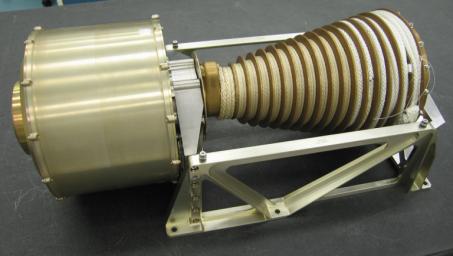
|
Device for Lowering Mars Science Laboratory Rover to the Surface
- Click the image above for a larger view
- Full-Res JPEG (1200 x 678) (105.1 kB)
- Full-Res TIFF (1200 x 678) (2.4 MB)
Caption:
This is hardware for controlling the final lowering of NASA's Mars Science Laboratory rover to the surface of Mars from the spacecraft's hovering, rocket-powered descent stage.
The photo shows the bridle device assembly, which is about two-thirds of a meter, or 2 feet, from end to end, and has two main parts. The cylinder on the left is the descent brake. On the right is the bridle assembly, including a spool of nylon and Vectran cords that will be attached to the rover.
When pyrotechnic bolts fire to sever the rigid connection between the rover and the descent stage, gravity will pull the tethered rover away from the descent stage. The bridle or tether, attached to three points on the rover, will unspool from the bridle assembly, beginning from the larger-diameter portion of the spool at far right. The rotation rate of the assembly, hence the descent rate of the rover, will be governed by the descent brake. Inside the housing of that brake are gear boxes and banks of mechanical resistors engineered to prevent the bridle from spooling out too quickly or too slowly. The length of the bridle will allow the rover to be lowered about 7.5 meters (25 feet) while still tethered to the descent stage.
Background Info:
The Starsys division of SpaceDev Inc., Poway, Calif., provided the descent brake. NASA's Jet Propulsion Laboratory, Pasadena, Calif., built the bridle assembly. Vectran is a product of Kuraray Co. Ltd., Tokyo. JPL, a division of the California Institute of Technology, manages the Mars Science Laboratory Project for the NASA Science Mission Directorate, Washington.
Cataloging Keywords:
| Name | Value | Additional Values |
|---|---|---|
| Target | Mars | |
| System | ||
| Target Type | Planet | |
| Mission | Mars Science Laboratory (MSL) | |
| Instrument Host | Curiosity Rover | |
| Host Type | Rover | |
| Instrument | ||
| Detector | ||
| Extra Keywords | Color, Rotation | |
| Acquisition Date | ||
| Release Date | 2008-11-19 | |
| Date in Caption | ||
| Image Credit | NASA/JPL-Caltech | |
| Source | photojournal.jpl.nasa.gov/catalog/PIA11428 | |
| Identifier | PIA11428 | |
